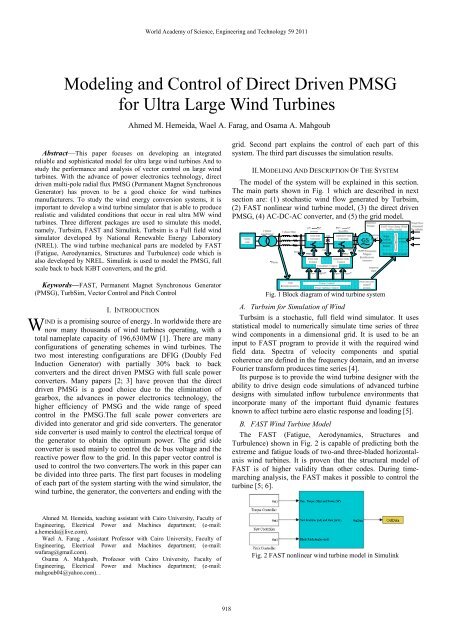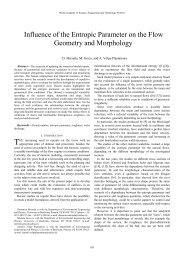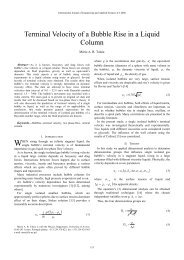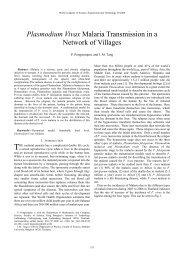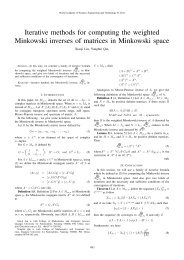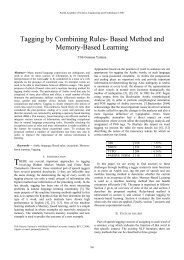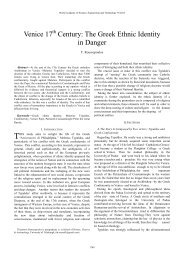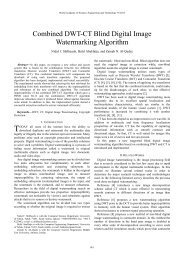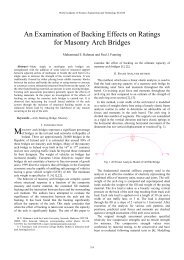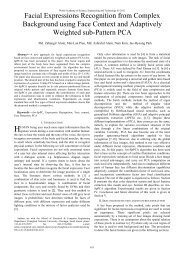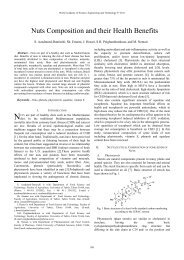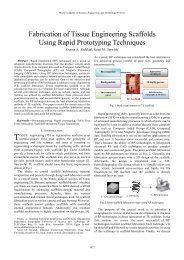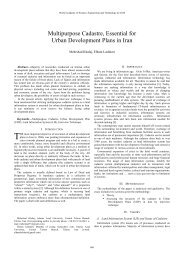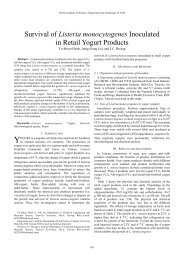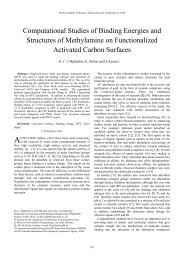Modeling and Control of Direct Driven PMSG for Ultra Large Wind ...
Modeling and Control of Direct Driven PMSG for Ultra Large Wind ...
Modeling and Control of Direct Driven PMSG for Ultra Large Wind ...
You also want an ePaper? Increase the reach of your titles
YUMPU automatically turns print PDFs into web optimized ePapers that Google loves.
Abstract—This paper focuses on developing an integrated<br />
reliable <strong>and</strong> sophisticated model <strong>for</strong> ultra large wind turbines And to<br />
study the per<strong>for</strong>mance <strong>and</strong> analysis <strong>of</strong> vector control on large wind<br />
turbines. With the advance <strong>of</strong> power electronics technology, direct<br />
driven multi-pole radial flux <strong>PMSG</strong> (Permanent Magnet Synchronous<br />
Generator) has proven to be a good choice <strong>for</strong> wind turbines<br />
manufacturers. To study the wind energy conversion systems, it is<br />
important to develop a wind turbine simulator that is able to produce<br />
realistic <strong>and</strong> validated conditions that occur in real ultra MW wind<br />
turbines. Three different packages are used to simulate this model,<br />
namely, Turbsim, FAST <strong>and</strong> Simulink. Turbsim is a Full field wind<br />
simulator developed by National Renewable Energy Laboratory<br />
(NREL). The wind turbine mechanical parts are modeled by FAST<br />
(Fatigue, Aerodynamics, Structures <strong>and</strong> Turbulence) code which is<br />
also developed by NREL. Simulink is used to model the <strong>PMSG</strong>, full<br />
scale back to back IGBT converters, <strong>and</strong> the grid.<br />
Keywords—FAST, Permanent Magnet Synchronous Generator<br />
(<strong>PMSG</strong>), TurbSim, Vector <strong>Control</strong> <strong>and</strong> Pitch <strong>Control</strong><br />
W<br />
I. INTRODUCTION<br />
IND is a promising source <strong>of</strong> energy. In worldwide there are<br />
now many thous<strong>and</strong>s <strong>of</strong> wind turbines operating, with a<br />
total nameplate capacity <strong>of</strong> 196,630MW [1]. There are many<br />
configurations <strong>of</strong> generating schemes in wind turbines. The<br />
two most interesting configurations are DFIG (Doubly Fed<br />
Induction Generator) with partially 30% back to back<br />
converters <strong>and</strong> the direct driven <strong>PMSG</strong> with full scale power<br />
converters. Many papers [2; 3] have proven that the direct<br />
driven <strong>PMSG</strong> is a good choice due to the elimination <strong>of</strong><br />
gearbox, the advances in power electronics technology, the<br />
higher efficiency <strong>of</strong> <strong>PMSG</strong> <strong>and</strong> the wide range <strong>of</strong> speed<br />
control in the <strong>PMSG</strong>.The full scale power converters are<br />
divided into generator <strong>and</strong> grid side converters. The generator<br />
side converter is used mainly to control the electrical torque <strong>of</strong><br />
the generator to obtain the optimum power. The grid side<br />
converter is used mainly to control the dc bus voltage <strong>and</strong> the<br />
reactive power flow to the grid. In this paper vector control is<br />
used to control the two converters.The work in this paper can<br />
be divided into three parts. The first part focuses in modeling<br />
<strong>of</strong> each part <strong>of</strong> the system starting with the wind simulator, the<br />
wind turbine, the generator, the converters <strong>and</strong> ending with the<br />
Ahmed M. Hemeida, teaching assistant with Cairo University, Faculty <strong>of</strong><br />
Engineering, Electrical Power <strong>and</strong> Machines department; (e-mail:<br />
a.hemeida@live.com).<br />
Wael A. Farag , Assistant Pr<strong>of</strong>essor with Cairo University, Faculty <strong>of</strong><br />
Engineering, Electrical Power <strong>and</strong> Machines department; (e-mail:<br />
wafarag@gmail.com).<br />
Osama A. Mahgoub, Pr<strong>of</strong>eesor with Cairo University, Faculty <strong>of</strong><br />
Engineering, Electrical Power <strong>and</strong> Machines department; (e-mail:<br />
mahgoub04@yahoo.com). .<br />
World Academy <strong>of</strong> Science, Engineering <strong>and</strong> Technology 59 2011<br />
<strong>Modeling</strong> <strong>and</strong> <strong>Control</strong> <strong>of</strong> <strong>Direct</strong> <strong>Driven</strong> <strong>PMSG</strong><br />
<strong>for</strong> <strong>Ultra</strong> <strong>Large</strong> <strong>Wind</strong> Turbines<br />
Ahmed M. Hemeida, Wael A. Farag, <strong>and</strong> Osama A. Mahgoub<br />
918<br />
grid. Second part explains the control <strong>of</strong> each part <strong>of</strong> this<br />
system. The third part discusses the simulation results.<br />
II. MODELING AND DESCRIPTION OF THE SYSTEM<br />
The model <strong>of</strong> the system will be explained in this section.<br />
The main parts shown in Fig. 1 which are described in next<br />
section are: (1) stochastic wind flow generated by Turbsim,<br />
(2) FAST nonlinear wind turbine model, (3) the direct driven<br />
<strong>PMSG</strong>, (4) AC-DC-AC converter, <strong>and</strong> (5) the grid model.<br />
Fig. 1 Block diagram <strong>of</strong> wind turbine system<br />
A. Turbsim <strong>for</strong> Simulation <strong>of</strong> <strong>Wind</strong><br />
Turbsim is a stochastic, full field wind simulator. It uses<br />
statistical model to numerically simulate time series <strong>of</strong> three<br />
wind components in a dimensional grid. It is used to be an<br />
input to FAST program to provide it with the required wind<br />
field data. Spectra <strong>of</strong> velocity components <strong>and</strong> spatial<br />
coherence are defined in the frequency domain, <strong>and</strong> an inverse<br />
Fourier trans<strong>for</strong>m produces time series [4].<br />
Its purpose is to provide the wind turbine designer with the<br />
ability to drive design code simulations <strong>of</strong> advanced turbine<br />
designs with simulated inflow turbulence environments that<br />
incorporate many <strong>of</strong> the important fluid dynamic features<br />
known to affect turbine aero elastic response <strong>and</strong> loading [5].<br />
B. FAST <strong>Wind</strong> Turbine Model<br />
The FAST (Fatigue, Aerodynamics, Structures <strong>and</strong><br />
Turbulence) shown in Fig. 2 is capable <strong>of</strong> predicting both the<br />
extreme <strong>and</strong> fatigue loads <strong>of</strong> two-<strong>and</strong> three-bladed horizontalaxis<br />
wind turbines. It is proven that the structural model <strong>of</strong><br />
FAST is <strong>of</strong> higher validity than other codes. During timemarching<br />
analysis, the FAST makes it possible to control the<br />
turbine [5; 6].<br />
Fig. 2 FAST nonlinear wind turbine model in Simulink
FAST model gives the accessibility to control the generator<br />
torque, the pitch angle, the yaw angle <strong>of</strong> the nacelle, the high<br />
speed shaft (HSS) brake <strong>and</strong> deploying the tip brakes. All<br />
these controllers can be implemented in Simulink.<br />
An interface has also been developed between FAST <strong>and</strong><br />
Simulink with Matlab enabling users to implement advanced<br />
controls in Simulink convenient block diagram <strong>for</strong>m. The<br />
FAST subroutines have been linked with a Matlab st<strong>and</strong>ard<br />
gateway subroutine in order to use the FAST equations <strong>of</strong><br />
motion in an S-Function that can be incorporated in a<br />
Simulink model [7].<br />
The wind turbine block, as shown in Fig. 3, contains the S-<br />
Function block with the FAST motion equations. It also<br />
contains blocks that integrate the degree <strong>of</strong> freedom<br />
accelerations to get velocities <strong>and</strong> displacements [7].<br />
Fig. 3 FAST wind turbine S-function<br />
To support concept studies aimed at assessing large wind<br />
technology, NREL developed the specifications <strong>of</strong> a<br />
representative utility-scale multimegawatt turbine now known<br />
as the “NREL <strong>of</strong>fshore 5-MW baseline wind turbine” [6]<br />
which is dedicated <strong>for</strong> the 5MW wind turbine. This wind<br />
turbine is a conventional three-bladed upwind variable-speed<br />
variable blade-pitch-to-feather-controlled turbine. To create<br />
the model, they obtained some broad design in<strong>for</strong>mation from<br />
the published documents <strong>of</strong> turbine manufacturers, with a<br />
heavy emphasis on the REpower 5MW machine.<br />
The specifications <strong>of</strong> the 5MW wind turbine is shown in<br />
Appendix [6].<br />
The output power <strong>of</strong> wind turbine can be defined as the<br />
difference between the power in the moving air be<strong>for</strong>e <strong>and</strong><br />
after the rotor [8];<br />
1 2 3<br />
P wt = ρπR VwC<br />
p ( λ,<br />
β )<br />
(1)<br />
2<br />
where ρ represents the air density, Vw represents the wind<br />
speed, R represents the blade radius, <strong>and</strong> Cp represents the<br />
power coefficient. The maximum value <strong>of</strong> Cp is between 0.4<br />
<strong>and</strong> 0.5 which is less than Betz’s limit 0.59. The value <strong>of</strong> Cp is<br />
function <strong>of</strong> tip speed ratio λ <strong>and</strong> pitch angle β.<br />
ω * R<br />
λ =<br />
(2)<br />
Vw<br />
where ωm is the rotational speed (rad/sec).<br />
The rotor torque can be expressed as;<br />
T<br />
wt<br />
1 2 3<br />
R Vw<br />
ρπ Cp<br />
( λ,<br />
β )<br />
= 2<br />
ω<br />
<strong>and</strong> the electro mechanical equation <strong>of</strong> the system can be<br />
expressed as:<br />
dω<br />
Twt − Te<br />
= J<br />
(4)<br />
dt<br />
World Academy <strong>of</strong> Science, Engineering <strong>and</strong> Technology 59 2011<br />
m<br />
(3)<br />
919<br />
where Te the electromagnetic torque <strong>of</strong> the generator <strong>and</strong> J<br />
is the inertia <strong>of</strong> the system.<br />
C. 5MW <strong>Direct</strong> <strong>Driven</strong> <strong>PMSG</strong> <strong>Modeling</strong><br />
1) Machine Equivalent Model<br />
Be<strong>for</strong>e obtaining the equivalent model <strong>of</strong> the radial flux<br />
<strong>PMSG</strong> in Fig. 4, it is necessary to calculate the total<br />
number <strong>of</strong> poles <strong>and</strong> introduce constraints on the leakage ratio<br />
<strong>of</strong> the machine. The equivalent model will then be derived in<br />
terms <strong>of</strong> number <strong>of</strong> stator conductors, Ns based on the physical<br />
construction <strong>of</strong> the machine described in [9], yielding the<br />
induced voltage, Epm, the synchronous inductance, Ls, <strong>and</strong> the<br />
stator resistance, Rs from equations described in [10; 14].<br />
Finally, parameters <strong>and</strong> machine equations are transposed in<br />
the rotor reference frame. This is more illustrated in [9; 10;<br />
11].<br />
Fig. 4 Electrical diagram in terms <strong>of</strong> N s<br />
The data <strong>for</strong> the <strong>PMSG</strong> is shown in Appendix.<br />
2) General Equations<br />
The back e.m.f Epmln max produced by the magnets depends<br />
on the mechanical rotational speed ωm(rad/sec). This is<br />
illustrated in the following equations;<br />
max<br />
ln = ω e * pm<br />
(5)<br />
Epm ϕ<br />
where ωe is the electrical rotational speed (rad/sec) <strong>and</strong> ϕpm<br />
is the flux linkage established by magnets (V.S).<br />
ω = P * ω<br />
(6)<br />
e<br />
m<br />
where P = number <strong>of</strong> pole pairs.<br />
3) Dqo Equations<br />
Almost all drive systems use the dynamic dqo model <strong>of</strong> a<br />
machine. This converts the 3 phase ac quantities to dc<br />
quantities, which can be easily controlled by a simple<br />
proptional integral (PI) controller. The trans<strong>for</strong>mation from 3<br />
phase variables with time varying (abc) frame to stationary<br />
dq0-frame defined in Fig. 5 [12].<br />
Fig. 5 Synchronization <strong>for</strong> the rotor position <strong>for</strong> the park<br />
trans<strong>for</strong>mation<br />
Machine equations based on the rotor reference position are<br />
described in Equations (7) <strong>and</strong> (8) <strong>and</strong> they are marked with<br />
the subscript “r”.<br />
r<br />
r r dIq<br />
r<br />
Vq −RsI<br />
q − Lq<br />
− ω rLd<br />
Id<br />
+ ωrϕ<br />
pm<br />
dt<br />
= (7)<br />
r r dI<br />
r<br />
Vd = −Rs<br />
I d − Ld<br />
+ ωr<br />
Lq<br />
I q (8)<br />
dt<br />
r<br />
d
The Variables Rs, Ld <strong>and</strong> Lq are the stator resistance, direct<br />
<strong>and</strong> quadrature inductance respectively <strong>of</strong> permanent magnet<br />
synchronous generator, where Ld = Lq = Ls.<br />
Fig. 6 shows the equivalent circuit <strong>of</strong> the <strong>PMSG</strong> in d-q axis.<br />
The electrical torque is shown in equation (9). It is clear that to<br />
control the electrical torque the q-axis current can be<br />
controlled.<br />
3 r<br />
Te Pϕ<br />
pmIq<br />
2<br />
= (9)<br />
Fig. 6 Equivalent circuit <strong>of</strong> <strong>PMSG</strong> in d-q reference frame<br />
D. Converter Model<br />
The back-to-back converter is composed by a <strong>for</strong>cecommutated<br />
rectifier <strong>and</strong> a <strong>for</strong>ce-commutated inverter as<br />
shown in Fig. 7 each is composed <strong>of</strong> six insulated gate bipolar<br />
transistor (IGBT) connected with a common DC-link.<br />
An advantage <strong>of</strong> this system is the dc link capacitor which<br />
decouples the two converters <strong>and</strong> a separate control on each<br />
converter can be used.<br />
Fig. 7 Structure <strong>of</strong> the back to back voltage source converter (VSC)<br />
A drawback <strong>of</strong> this system is the increase <strong>of</strong> the switching<br />
losses <strong>and</strong> also the presence <strong>of</strong> the DC-Link capacitor since it<br />
is bulky <strong>and</strong> heavy. It increases the cost <strong>and</strong> may be <strong>of</strong> most<br />
importance. This reduces the overall life time <strong>of</strong> the system<br />
[13]. The equivalent circuit <strong>of</strong> a voltage source converter is<br />
shown in Fig. 8.<br />
Fig. 8 Equivalent circuit <strong>of</strong> voltage source converter with ideal switch<br />
The DC current Idc is expressed as;<br />
I dc ( ha<br />
( t)<br />
Ia<br />
+ hb<br />
( t)<br />
Ib<br />
+ hc<br />
( t)<br />
Ic<br />
)<br />
= (10)<br />
where ha(t), hb(t) <strong>and</strong> hc(t) are the switching status <strong>of</strong> the<br />
switches in VSC.<br />
The output phase voltages are expressed by the following<br />
equation, which are dependent on ha(t), hb(t) <strong>and</strong> hc(t).<br />
⎡Van<br />
⎤ ⎡ 2<br />
⎢ ⎥ V ⎢<br />
⎢V<br />
⎥ = dc<br />
bn ⎢<br />
−1<br />
3<br />
⎢ ⎥<br />
⎣Vcn<br />
⎦<br />
⎢<br />
⎣−1<br />
−1<br />
2<br />
−1<br />
−1⎤⎡ha<br />
( t)<br />
⎤<br />
⎥⎢<br />
⎥<br />
−1<br />
⎥⎢hb<br />
( t)<br />
⎥<br />
2 ⎥<br />
⎦<br />
⎢ ⎥<br />
⎣hc(<br />
t)<br />
⎦<br />
(11)<br />
This topology is used <strong>for</strong> full rating power converter in<br />
some large scale wind turbines [14; 15].<br />
World Academy <strong>of</strong> Science, Engineering <strong>and</strong> Technology 59 2011<br />
920<br />
E. Grid Model<br />
The grid can be represented as shown in Fig. 9. The output<br />
<strong>of</strong> the coupling is represented by subscript U <strong>and</strong> grid voltage<br />
is represented by subscript E.<br />
The voltage equation per phase can be described as follows:<br />
dI<br />
E = U + Rs<br />
* I + Ls<br />
*<br />
(12)<br />
dt<br />
where Rs <strong>and</strong> Ls represent the equivalent series resistance<br />
<strong>and</strong> inductor <strong>of</strong> the filter <strong>and</strong> trans<strong>for</strong>mer between grid <strong>and</strong><br />
inverter output.<br />
Fig. 9 Grid Side Converter<br />
For a three phase voltages with a rotating frame angle Ө<br />
which starts rotating with phase a, the amplitude <strong>of</strong> the phase<br />
voltages <strong>of</strong> the grid (Ean, Ebn, Ecn) which equals Es will be<br />
placed on the d- axis (Ed = Es). The q-axis component voltage<br />
will be zero. Then converting Equation (12) to d-q frame<br />
results in the following equations;<br />
r<br />
r r dIq<br />
r<br />
Vq = RsIq<br />
+ Lq<br />
+ ω rLd<br />
Id<br />
+ 0<br />
(13)<br />
dt<br />
r<br />
r r dI r<br />
V d<br />
d = RsI<br />
d + Ld<br />
− ω rLq<br />
Iq<br />
+ Es<br />
(14)<br />
dt<br />
where Vd r <strong>and</strong> Vq r are the d-q output voltages <strong>of</strong> the<br />
inverter, ωr is the grid frequency in rad/sec, Ld <strong>and</strong> Lq are the<br />
inductance in d-q axis which equal Ls <strong>and</strong> Id r <strong>and</strong> Iq r are the<br />
d-q axis currents.<br />
The equations <strong>of</strong> active <strong>and</strong> reactive power converted to<br />
grid are shown in Equations (15), (16). It’s shown that to<br />
control active power the d-axis current must be controlled <strong>and</strong><br />
to control reactive power the q-axis current is needed to be<br />
controlled as shown in the following equations.<br />
3<br />
P Es<br />
* Id<br />
2<br />
= (15)<br />
3<br />
Q Es<br />
* Iq<br />
2<br />
= (16)<br />
The data <strong>for</strong> the grid configuration is shown in Appendix.<br />
III. CONTROL OF <strong>PMSG</strong> BASED WIND TURBINES<br />
The requirements <strong>of</strong> any turbine control system are to<br />
extract almost all the output power <strong>of</strong> the wind turbine. Four<br />
regions can be defined <strong>for</strong> the control <strong>of</strong> the wind turbine as<br />
shown in Fig. 10.<br />
In region 1, the output power from the wind turbine is too<br />
low, this won’t be sufficient to operate the wind turbine.<br />
Region 1.5 is a linear transition between regions 1 <strong>and</strong> 2.<br />
This starts from 6.9 rpm <strong>and</strong> ends at 30% above the starting<br />
rotor speed.
In region 2, the controller is adjusted to extract almost all<br />
the output power available in the wind turbine. This is done by<br />
changing the electromagnetic torque <strong>of</strong> the generator to<br />
always work on maximum power coefficient. This region ends<br />
at 99% <strong>of</strong> the rated rotor speed. This is done by the generator<br />
side converter <strong>and</strong> this is more illustrated in Section III.A.<br />
Region 2.5 is a linear transition between regions 2 <strong>and</strong> 3.<br />
This region is required to limit tip speed at rated power. This<br />
region ends at rated rotor speed.<br />
In region 3, the generator electromagnetic torque is kept<br />
constant <strong>and</strong> the pitch angle is adjusted to keep the rotor speed<br />
constant at its nominal value. There<strong>for</strong>e, the output power is<br />
kept constant.<br />
Fig. 10 Power curve <strong>for</strong> wind turbine<br />
A. Generator Side Converter <strong>Control</strong><br />
Type <strong>of</strong> control used is field oriented control (FOC) as<br />
shown in<br />
Fig. 11. This type <strong>of</strong> control gives high per<strong>for</strong>mance. FOC<br />
uses the shaft speed, obtained by an encoder as a feedback in<br />
the control strategy.<br />
The d <strong>and</strong> q axis current component represents the<br />
components <strong>of</strong> flux <strong>and</strong> torque. The torque <strong>and</strong> flux can be<br />
controlled separately <strong>for</strong> the current control loops.<br />
Constant Torque Angle <strong>Control</strong> (CTA) is the control<br />
technique used to control the d <strong>and</strong> q axis currents. CTA keeps<br />
the torque angle constant (angle between the stator current<br />
vector <strong>and</strong> the rotor permanent magnet flux) at 90 ° . This is<br />
done by keeping the stator current reference in d-axis at zero,<br />
to produce maximum torque per ampere; there<strong>for</strong>e the<br />
resistive losses are minimized. The stator current reference in<br />
q-axis is calculated from the reference torque using Equation<br />
(9) [16].<br />
The required d-q components <strong>of</strong> the voltage vector are<br />
derived from two PI current controllers. After the PI current<br />
controllers, compensation terms in the following two<br />
equations are added to improve the transient response. They<br />
are obtained from Equations (7) <strong>and</strong> (8).<br />
r<br />
Component → 1 = ωrLq<br />
Iq<br />
(17)<br />
r<br />
Component 2 = −ω<br />
rLd Id<br />
+ ωr<br />
* ϕ pm<br />
→ (18)<br />
Space Vector Modulation (SVM) is the technique used to<br />
create the duty cycles <strong>of</strong> the desired reference voltages. The<br />
PWM switching signals <strong>for</strong> the power converter switching<br />
devices can be obtained by comparing the duty cycles with the<br />
carrier signal in order to create. The PI parameters are<br />
designed using sisotool in MATLAB as described in [17].<br />
World Academy <strong>of</strong> Science, Engineering <strong>and</strong> Technology 59 2011<br />
921<br />
Fig. 11 Generator Side <strong>Control</strong><br />
The reference <strong>of</strong> the electromagnetic torque Tem * can be<br />
calculated by using optimal torque control method [18]. This<br />
control method uses the measured rotational speed (rad/sec) <strong>of</strong><br />
the shaft <strong>and</strong> the parameters <strong>of</strong> the wind turbine to obtain the<br />
optimal operating point. The output wind turbine power is<br />
obtained from Equation (3).<br />
1 2 3 1 C p(<br />
λ,<br />
β ) 5 3<br />
Pwt ρπ R VwCp<br />
( λ,<br />
β ) =<br />
ρπR<br />
ω<br />
2<br />
2 3<br />
m<br />
λ<br />
= (19)<br />
By replacing λ(t) by λopt <strong>and</strong> Cp(λ,β) = Cp(λopt,β), the<br />
reference power can be obtained in region 2.<br />
Pwtopt where;<br />
3<br />
Kωm<br />
= (20)<br />
1 C p(<br />
λ,<br />
β ) 5<br />
K = ρπR<br />
2 3<br />
λ<br />
rad 2<br />
N.<br />
m /( )<br />
sec<br />
(21)<br />
The reference torque is calculated as follows;<br />
Twtopt 2<br />
Kωm<br />
= (22)<br />
The value <strong>of</strong> K <strong>for</strong> the 5MW wind turbine system is<br />
23342.87N.m/rpm 2 .<br />
B. Pitch Angle <strong>Control</strong><br />
The basic aim <strong>of</strong> pitch control scheme is to keep constant<br />
rated power at region 3. Blade pitch actuator <strong>for</strong> the 5MW<br />
wind turbine has a maximum rate limit <strong>of</strong> 8 degree/sec. Also,<br />
the minimum <strong>and</strong> maximum blade pitch settings are 0° <strong>and</strong><br />
90° respectively [6]. The blade pitch actuator is a second order<br />
system with a very high natural frequency <strong>of</strong> 30Hz <strong>and</strong> a<br />
damping ratio <strong>of</strong> 2% [6].<br />
Fig. 12 shows the control scheme <strong>for</strong> pitch system. The<br />
rotational speed is kept constant at rated speed by increasing<br />
pitch angle. This will reduce the aerodynamic torque produced<br />
by the wind turbine. Below rated rotor speed the pitch angle is<br />
adjusted at its lower limit.<br />
The PI gains are designed by linearizing the FAST model at<br />
wind speed <strong>of</strong> 18m/sec <strong>and</strong> by using sisotool in Matlab the<br />
gains are obtained.<br />
Fig. 12 Pitch Angle <strong>Control</strong> Scheme
C. Grid Side Converter <strong>Control</strong><br />
The aim <strong>of</strong> the control as shown in<br />
Fig. 13 is to transfer all the active power produced by the<br />
wind turbine to the grid <strong>and</strong> also to produce no reactive power<br />
so that unity power factor is obtained, unless the grid operator<br />
requires reactive power compensation. In<br />
Fig. 13 the phase locked loop (PLL) is used to synchronize<br />
the three phase voltage with the grid voltage. The main aim <strong>of</strong><br />
the controller is to:<br />
• Regulate the DC bus voltage constant to be greater than the<br />
amplitude <strong>of</strong> the grid line to line voltage. This is done by<br />
controlling the d-axis current component. So, if turbine Power<br />
Pt <strong>and</strong> generator power Pg are equal, Vdc must be constant.<br />
dVdc<br />
Pt<br />
Pg<br />
Ic C = −<br />
dt Vdc<br />
Vdc<br />
= (23)<br />
where Ic is the capacitor current.<br />
• <strong>Control</strong> the reactive power through the q current component<br />
as can be concluded from Equation (16).<br />
A compensation terms mentioned in the following<br />
equations, will be added to improve the transient response <strong>of</strong><br />
the system which can be concluded from Equations (13) <strong>and</strong><br />
(14).<br />
r<br />
Component → 1 = −ωr<br />
LqI<br />
q + Es<br />
(24)<br />
r<br />
Component → 2 = ωrLd<br />
Id<br />
(25)<br />
Fig. 13 Grid Side Converter <strong>Control</strong><br />
IV. SIMULATION RESULTS<br />
The system is tested under two conditions. The first<br />
condition with the wind speed changes in steps. The pitch<br />
angle response <strong>for</strong> step changes <strong>for</strong> wind speed is shown in<br />
Fig. 14. The wind is changing from 12 to 20m/sec in 1m/sec<br />
steps. It is also observed that the rotor speed raises only 5% <strong>of</strong><br />
the rated value. The power has an average value <strong>of</strong> 0.998p.u<br />
over the time period <strong>of</strong> 100sec. These values are within<br />
reasonable range.<br />
World Academy <strong>of</strong> Science, Engineering <strong>and</strong> Technology 59 2011<br />
922<br />
Fig. 14 Pitch angle response <strong>for</strong> step changes in wind speeds<br />
Under the second condition a stochastic wind speed<br />
generated by Turbsim [4] will be used. The controller is tested<br />
with wind pr<strong>of</strong>ile named great planes wind pr<strong>of</strong>ile (GP_LLJ).<br />
This wind pr<strong>of</strong>ile is st<strong>and</strong>ard, validated by IEC, <strong>and</strong> has a<br />
coherent structure. The hub height wind speed is shown in Fig.<br />
15 with an average value <strong>of</strong> 18m/sec <strong>and</strong> a st<strong>and</strong>ard deviation<br />
<strong>of</strong> 1.15. It is shown that the rotor speed changes within 5% <strong>of</strong><br />
the rated value. This value is within reasonable range. The<br />
power has an average value <strong>of</strong> 0.92p.u over the time period <strong>of</strong><br />
100sec.<br />
Fig. 15 Pitch angle response <strong>for</strong> stochastic wind speeds<br />
A. Generator <strong>and</strong> Grid Side <strong>Control</strong><br />
Two cases will be studied in this study. In the first case the<br />
generator <strong>and</strong> grid side controller are tested under wind speed<br />
steps <strong>of</strong> 2m/sec from 6 to 10m/sec as shown in Fig. 16.<br />
Fig. 16 Speed, electromagnetic torque <strong>and</strong> dc bus voltage response<br />
<strong>for</strong> wind speed variations<br />
For every increase in wind speed the wind turbine<br />
aerodynamic torque increases <strong>and</strong> correspondingly the<br />
electromagnetic torque increases. The rotor speed also
increases <strong>and</strong> settles after duration <strong>of</strong> 5sec. This is due to the<br />
large inertia <strong>of</strong> the system. The dc bus voltage is set to be at<br />
1.6p.u. It is also observed that the dc bus voltage isn’t affected<br />
by the variations <strong>of</strong> wind speed. This is due to the electrical<br />
system response is very fast compared to the mechanical time<br />
constant.<br />
Fig. 17 a <strong>and</strong> b show the d <strong>and</strong> q-axis responses <strong>for</strong> the<br />
generator currents. The generator d-axis current is set all over<br />
the simulation to zero to get the maximum torque/ampere <strong>and</strong><br />
the q-axis is directly tracking the electromagnetic torque. The<br />
ripple is around 2%.<br />
Fig. 17 c <strong>and</strong> d show the d <strong>and</strong> q-axis responses <strong>for</strong> the grid<br />
currents. The grid q-axis current is set all over the simulation<br />
to zero to get zero reactive power <strong>and</strong> the d-axis component is<br />
directly tracking the power flow from the turbine to the grid.<br />
The ripple in the d-axis current is around 4%. But in the case<br />
<strong>of</strong> the q-axis it increases to 10%.<br />
Fig. 18 shows the phase a current <strong>of</strong> the grid <strong>for</strong> 10 cycles.<br />
It shows a THD <strong>of</strong> 3.76% which is quite acceptable.<br />
Fig. 17 D <strong>and</strong> Q axis currents response <strong>for</strong> generator <strong>and</strong> grid<br />
Fig. 18 Phase A Grid Current.<br />
In the second case the controller is tested under turbulence<br />
wind which has a mean wind speed <strong>of</strong> 9.2m/sec, st<strong>and</strong>ard<br />
deviation <strong>of</strong> 0.381 <strong>and</strong> a power law exponent <strong>of</strong> 0.143 as<br />
shown in Fig. 19. The wind speed has stochastic wind<br />
variations. It varies about a mean value <strong>of</strong> 9m/sec. The rotor<br />
speed increases at first then it reaches a steady state value.<br />
Whenever the wind speed variations about the mean wind<br />
World Academy <strong>of</strong> Science, Engineering <strong>and</strong> Technology 59 2011<br />
speed the system doesn’t sense these variations due to the<br />
large inertia <strong>of</strong> the rotor. The generator is only affected by the<br />
mean wind speed.<br />
Fig. 19 Speed, electromagnetic torque <strong>and</strong> dc bus voltage response<br />
<strong>for</strong> wind speed variations<br />
V. CONCLUSION<br />
The main objective <strong>of</strong> this paper was the modeling <strong>and</strong><br />
simulation <strong>of</strong> the ultra large wind turbine system using<br />
validated models <strong>of</strong> wind turbine mechanical <strong>and</strong> electrical<br />
systems. Then the electrical system consisting <strong>of</strong> the<br />
generator, back to back VSC <strong>and</strong> the grid have been described<br />
mathematically component by component. Then the<br />
per<strong>for</strong>mance <strong>and</strong> analysis <strong>of</strong> vector control <strong>and</strong> the pitch<br />
control algorithms have been studied on the system. The<br />
simulation was conducted under conditions <strong>of</strong> step wind<br />
speeds <strong>and</strong> stochastic wind flow generated by TurbSim. The<br />
simulation results have shown the correct functioning <strong>of</strong> the<br />
controllers applied on each component in the whole system.<br />
APPENDIX<br />
PROPERTIES FOR THE NREL 5-MW BASELINE WIND<br />
TURBINE<br />
<strong>Wind</strong> Turbine Parameters<br />
Rating 5MW<br />
Rotor Orientation, Configuration Upwind, 3 Blades<br />
<strong>Control</strong> Variable Speed,<br />
Collective Pitch<br />
Rotor <strong>and</strong> turbine inertia about the<br />
shaft<br />
2<br />
38,759,228 Kg .m<br />
Generator Parameters<br />
Nominal Power Pgen,nom<br />
5.3MW<br />
Nominal Torque Tgen,nom<br />
4.18MN.m<br />
Generator inertia about the shaft 5,025,500 Kg .m<br />
2<br />
Generator Side Characteristics<br />
Parameters Value<br />
No. <strong>of</strong> pair poles, P. 100<br />
The r.m.s induced no load voltage at<br />
rated speed, Epmln rms .<br />
2.31KV<br />
The stator resistance, Rs. 0.08Ω<br />
The magnetizing inductance, Lsm. 3.352mH<br />
The leakage inductance, Lsl. 5.028mH<br />
Grid Side Characterstics<br />
Parameters Value<br />
Grid Voltage. 4KV<br />
923
Line filter inductance. 4mH<br />
DC bus voltage. 6.4KV<br />
DC bus capacitance. 4000µF<br />
ACKNOWLEDGMENT<br />
This project has been funded by the Science <strong>and</strong><br />
Technology Development Fund (STDF) project number 1411.<br />
REFERENCES<br />
[1] Association, World <strong>Wind</strong> Energy. World <strong>Wind</strong> Energy Report. Cairo,<br />
Egypt : World <strong>Wind</strong> Energy Association WWEA 2011, 31 October.<br />
[2] H. Polinder, F.F.A. van der Pijl, G.J. de Vilder, P. Tavner, “Comparison<br />
<strong>of</strong> direct-drive <strong>and</strong> geared generator concepts <strong>for</strong> wind turbines”, IEEE<br />
Trans. Energy Conversion, Vol. 21, pp. 725-733, September 2006.<br />
[3] D. Bang, H. Polinder, G. Shrestha, <strong>and</strong> J.A. Ferreira, “Review <strong>of</strong><br />
generator systems <strong>for</strong> direct-drive wind turbines”, in Proc. EWEC<br />
(European <strong>Wind</strong> Energy Conference & Exhibition,) Brussels, Belgium,<br />
March 31 - April 3, 2008.<br />
[4] J. Jonkman, B.J. “Turbsim user’s guide”. s.l. : NREL/TP-500-46198:<br />
National Renewable Energy Laboratory., August 2009.<br />
[5] Sayooj B Krishna, Reeba S V. “Simulation Of <strong>Wind</strong> Turbine With<br />
Switched Reluctance Generator by FAST <strong>and</strong> Simulink”. .November<br />
2009, National Conference on Technological Trends.<br />
[6] J. Jonkman, S. Butterfield, W. Musial, <strong>and</strong> G. Scott. “Definition <strong>of</strong> a 5-<br />
MW Reference <strong>Wind</strong> Turbine <strong>for</strong> Offshore System Development”. s.l. :<br />
NREL, February 2009.<br />
[7] J. Jonkman, B.J. “FAST User’s Guide, Technical Report”. s.l. :<br />
NREL/EL-500-38230: National Renewable Energy Laboratory., August,<br />
2005.<br />
[8] Cristian Busca, Ana-Irina Stan, Tiberiu Stanciu <strong>and</strong> Daniel Ioan Stroe.<br />
“<strong>Control</strong> <strong>of</strong> Permanent Magnet Synchronous <strong>of</strong> large wind turbines”.<br />
Denmark : Departament <strong>of</strong> Energy Technology: Aalborg University,<br />
November 2010, Industrial Electronics (ISIE), ieee, pp. 3871 - 3876 .<br />
[9] D. Bang, H. Polinder, J.A. Ferreira. “Design <strong>of</strong> Transverse Flux<br />
Permanent Magnet Machines <strong>for</strong> <strong>Large</strong> <strong>Direct</strong>-Drive <strong>Wind</strong> Turbines”.<br />
Electrical Power Processing / DUWIND, Delft University <strong>of</strong><br />
Technology. Netherl<strong>and</strong>s : Delft University <strong>of</strong> Technology, 2010. phD<br />
Thesis.<br />
[10] Hui Li, Zhe Chen. “Design Optimization <strong>and</strong> Evaluation <strong>of</strong> Different<br />
<strong>Wind</strong> Generator Systems”. February 2009, Sustainable Power<br />
Generation <strong>and</strong> Supply, 2009. SUPERGEN '09.<br />
[11] Li, Hui, Chen, Zhe <strong>and</strong> Polinder, H. “Optimization <strong>of</strong> multibrid<br />
permanent-magnet wind generator systems”. Security & New Technol.,<br />
Chongqing Univ : IEEE Transactions on Energy conversion, March<br />
2009, IEEE Transactions on Energy conversion , Vol. 24, pp. 82-92.<br />
[12] P. C. Krause, O. Wasynczuk, <strong>and</strong> S. D. Sudho. “Analysis <strong>of</strong> Electric<br />
Machinery <strong>and</strong> Drive System”s. s.l. : John Wiley & Sons, , 2002.<br />
[13] Floren lov, FredeBlaabjerg. “Power electronics <strong>Control</strong> <strong>of</strong> wind energy<br />
in distributed power systems”. Department <strong>of</strong> energy technology,<br />
Aaloborg university. 2009. pp. 1–16.<br />
[14] Shuhui Li, Timothy A.Haskew, Ling Xu. “Conventional <strong>and</strong> novel<br />
control designs <strong>for</strong> direct driven <strong>PMSG</strong> wind turbines”. 3, March 2010,<br />
Electric Power Systems Research, Vol. 80, pp. 328-338.<br />
[15] Remus Teodorescu, Pedro Rodriguez. “Thesis in Reactive power control<br />
<strong>for</strong> wind power plant with STATCOM”. Institute <strong>of</strong> Energy Technology-<br />
Pontoppidanstræde 101. 2010. Master thesis.<br />
[16] Busca, C., et al., et al. “Vector control <strong>of</strong> <strong>PMSG</strong> <strong>for</strong> wind turbine<br />
applications”. s.l. : Dept. <strong>of</strong> Energy Technol., Aalborg Univ., Aalborg,<br />
Denmark , 2010 , Industrial Electronics (ISIE), pp. 3871 - 3876 .<br />
[17] Andreea Cimpoeru, Kaiyuan Lu. “Encoderless Vector <strong>Control</strong> <strong>of</strong> <strong>PMSG</strong><br />
<strong>for</strong> wind turbine applications”. Institute <strong>of</strong> Energy Technology, Institute<br />
<strong>of</strong> energy technology. s.l. : AALBORG University, 2010. Master Thesis.<br />
[18] Michael J. Grimble, Pr<strong>of</strong>essor Michael A. Johnson. “Optimal <strong>Control</strong> <strong>of</strong><br />
<strong>Wind</strong> Energy Conversion Systems”. August 2007 .<br />
World Academy <strong>of</strong> Science, Engineering <strong>and</strong> Technology 59 2011<br />
924


